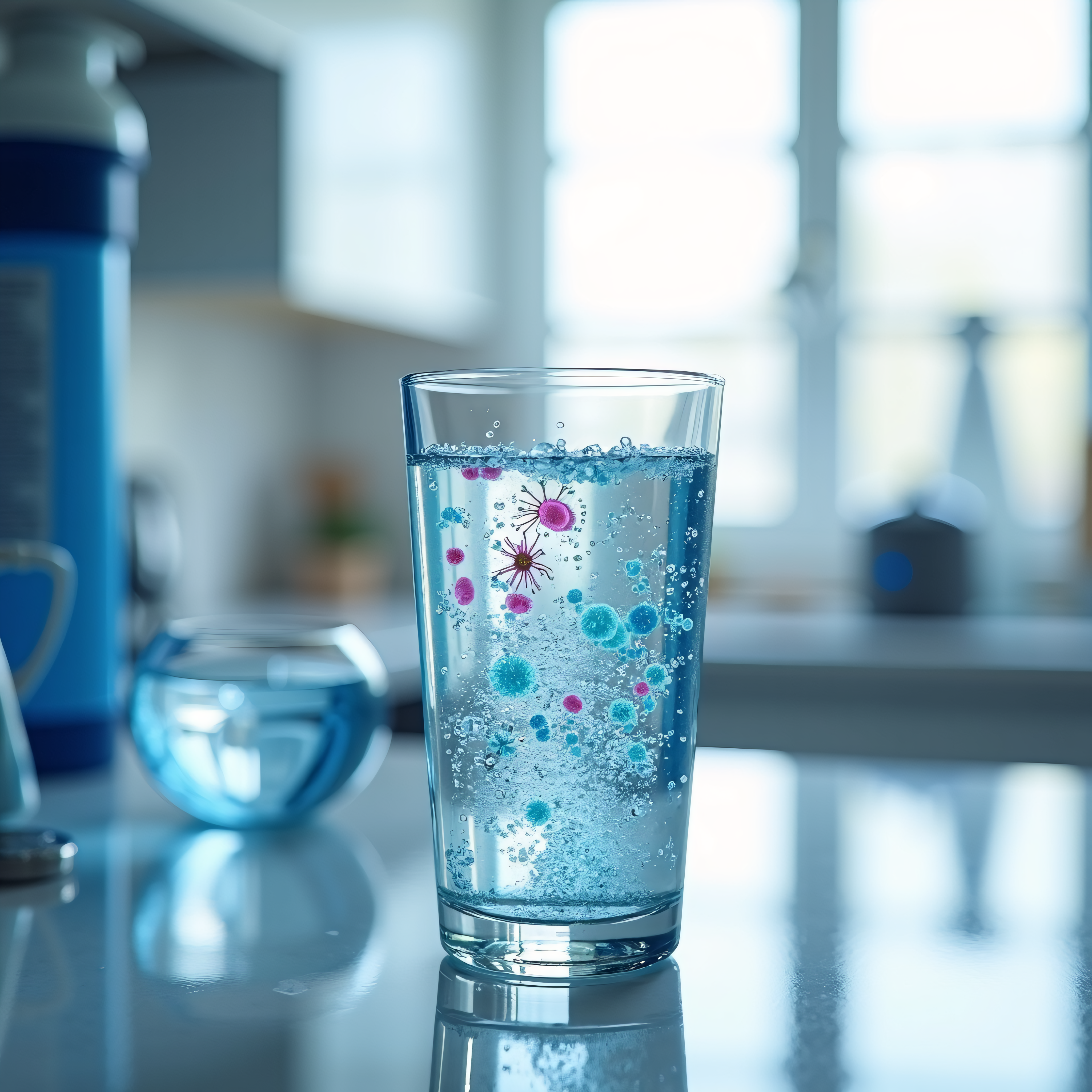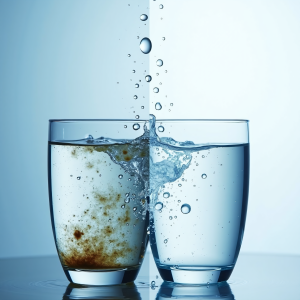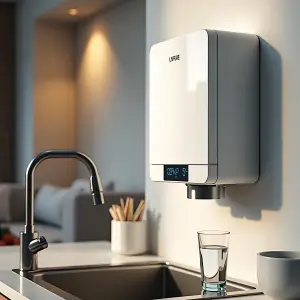Understanding Water & Its Journey to Your Tap
The water cycle, a continuous process of evaporation, condensation, and precipitation, provides the foundation for our drinking water sources. However, this natural process can be easily disrupted by human activity and environmental factors, leading to contamination. Our drinking water typically originates from one of two main sources: public water systems and private wells.
Public water systems, also known as municipal water supplies, undergo extensive treatment to ensure safety and potability. This multi-stage process typically includes coagulation, sedimentation, filtration, and disinfection [9]. Coagulation involves adding chemicals to clump together impurities, allowing them to settle out during sedimentation. Filtration removes remaining particles, while disinfection, often using chlorine or chloramine, eliminates harmful microorganisms.
Private wells, on the other hand, draw water directly from underground aquifers. While often perceived as pristine, well water is vulnerable to contamination from surface runoff, leaking septic systems, and subsurface pollutants. This makes regular testing and potential treatment crucial for well water users.
The Environmental Protection Agency (EPA) sets national standards for drinking water quality, outlining maximum contaminant levels (MCLs) for various substances. These regulations aim to protect public health by limiting the presence of harmful contaminants in drinking water. However, it’s crucial to remember that these standards apply primarily to public water systems, leaving private well owners responsible for testing and treatment.
Source: https://www.cdc.gov/wells/index.html
Decoding Water Quality: Key Contaminants You Should Know
Water contaminants can be broadly categorized into inorganic, organic, and biological substances. Understanding these categories is crucial for effective water treatment and purification.
*Inorganic contaminants* are naturally occurring or human-made minerals and chemicals. These include:
- Lead: Lead contamination often stems from aging lead pipes, solder, and other plumbing components. Exposure to lead, even at low levels, can cause serious health problems, particularly in children, affecting neurological development and cognitive function. The EPA has established strict limits for lead in drinking water.
- Nitrates/Nitrites: These compounds often originate from fertilizers used in agriculture and can leach into groundwater. High nitrate levels pose significant risks to infants, causing a condition known as “blue baby syndrome,” which can lead to serious health complications.
- Arsenic: Arsenic can occur naturally in groundwater or be introduced through industrial runoff. Long-term exposure to arsenic can cause various cancers and other health problems. The EPA has established stringent standards to limit arsenic levels in drinking water.
- Fluoride: While fluoride is added to many public water supplies to prevent tooth decay, excessive fluoride can lead to dental fluorosis and other health concerns. The optimal level of fluoride is a subject of ongoing debate and varies depending on local conditions and individual needs.
*Organic contaminants* are carbon-based compounds, many of which are man-made. These include:
- Pesticides & Herbicides: These chemicals, widely used in agriculture, can contaminate water sources through runoff. Exposure to pesticides and herbicides has been linked to various health problems, including hormonal disruption and cancer
- Volatile Organic Compounds (VOCs): VOCs are organic chemicals that easily evaporate at room temperature. They are often found in industrial discharges, gasoline, and other sources. Exposure to VOCs can cause a range of health effects, from headaches and nausea to liver and kidney damage.
- Pharmaceuticals: The presence of pharmaceuticals in water is an emerging concern, as these compounds can enter water sources through wastewater treatment plants. The long-term effects of exposure to low levels of pharmaceuticals are not fully understood but are a subject of ongoing research and concern.
*Biological contaminants* include microorganisms such as bacteria, viruses, and parasites. These can contaminate water sources through sewage, animal waste, and other sources [29]. Examples include:
- Bacteria (E. coli, Salmonella): These bacteria can cause gastrointestinal illnesses, ranging from mild diarrhea to severe infections.
- Viruses (Norovirus, Rotavirus): These viruses can cause vomiting, diarrhea, and dehydration, particularly in children and the elderly.
- Parasites (Giardia, Cryptosporidium): These parasites can cause gastrointestinal distress and other health problems.
Understanding Key Water Quality Indicators
Beyond specific contaminants, several key parameters help define overall water quality.
- Total Dissolved Solids (TDS): TDS measures the total amount of dissolved minerals and salts in water. While some minerals are beneficial, high TDS can affect taste, odor, and lead to scaling in pipes and appliances. Low TDS, on the other hand, can increase the corrosivity of water, potentially leaching metals from pipes. The ideal TDS range for drinking water generally falls between 50 and 500 ppm (parts per million), though this can vary depending on individual preferences and local conditions.
- pH Levels: pH measures the acidity or alkalinity of water, ranging from 0 to 14, with 7 being neutral. The ideal pH range for drinking water is generally between 6.5 and 8.5. Water outside this range can be corrosive, affecting pipes and appliances, and may also affect taste.
- Water Hardness: Water hardness refers to the concentration of calcium and magnesium ions in water. Hard water can cause scale buildup in pipes and appliances, reducing their efficiency and lifespan. It can also lead to problems with soap lather and potentially affect skin and hair. Water softening methods, such as ion exchange, can mitigate these issues.
Testing Your Water: DIY Kits vs. Professional Analysis
Regular water testing is crucial, regardless of your water source. Both DIY kits and professional lab analyses have their place. DIY kits, available at most hardware stores, provide a quick and affordable screening for common contaminants like bacteria, lead, and nitrates. They’re a good first step, but often lack the sensitivity and comprehensive analysis of a professional lab test.
Professional lab analyses, while more expensive, offer a detailed assessment of a wide range of contaminants, providing accurate and reliable results. It’s generally recommended to have your water tested annually, or more frequently if you suspect a problem.
Water Treatment Options: From Filters to Softeners
Once you understand your water’s composition, you can choose the appropriate treatment option.
- Filtration Systems: These remove sediment, chlorine, lead, and other contaminants. Options range from pitcher filters and faucet filters to whole-house filters.
- Water Softeners: These utilize ion exchange to remove calcium and magnesium, softening hard water.
- Reverse Osmosis (RO) Systems: RO systems provide a thorough purification by forcing water through a semi-permeable membrane, removing a wide range of contaminants.
- UV Sterilization: UV systems use ultraviolet light to kill bacteria and viruses.
- Distillation: Though energy intensive, distillation can effectively remove virtually all contaminants.
Check out our Blog on The Ultimate Guide to Reverse Osmosis for a Healthier Home.
Check out our Blog on A Deep Dive into UV Water Purification
Check out our Blog on A Comprehensive Guide to Gravity Water Purifiers
Maintaining Your Water System
Maintaining your water system is essential for continued safe water. Regular filter changes (as recommended by the manufacturer) are crucial for filtration systems. Water softeners require periodic salt replenishment and maintenance. Periodically inspect pipes and plumbing for leaks or corrosion. And continue to re-test your water regularly to ensure your treatment system is effective. Check out our Blog on Water Purifier Maintenance: A Complete Guide to Clean, Safe Drinking Water
Frequently Asked Questions About Water
Q: Why is drinking enough water so important for overall health?
Staying hydrated with sufficient daily water intake is crucial! Water regulates body temperature, transports nutrients, and flushes out waste. Proper hydration impacts everything from energy levels and cognitive function to skin health and digestion. Aim for around 8 glasses a day, adjusting based on activity level and climate – listen to your body’s thirst cues!
Q: What are the signs of dehydration, and how can I quickly rehydrate?
Recognizing dehydration symptoms is key. Look for thirst, dark urine, fatigue, dizziness, and dry mouth. Mild dehydration can be quickly addressed by slowly sipping water – avoid gulping! Electrolyte-rich drinks can also help replenish lost minerals, especially after intense exercise or illness. Prioritize consistent water consumption throughout the day.
Q: Is all water created equal? Should I be drinking filtered water?
While all water is essential, its quality varies. Filtered water removes contaminants like chlorine, lead, and bacteria, improving taste and potentially offering health benefits. Consider a water filter pitcher or whole-house system, especially if your tap water source isn’t known for purity. Bottled drinking water is an option, but less sustainable.
Q: How much water should I drink during exercise to maintain performance?
Hydration needs increase significantly during physical activity. Before exercise, drink about 16-20 ounces of water. During, sip 3-8 ounces every 15-20 minutes, adjusting for intensity and duration. After exercise, replenish fluids lost through sweat – weigh yourself before and after to gauge fluid loss and drink accordingly.
Q: Can drinking water actually help with weight management?
Yes! Drinking water before meals can create a feeling of fullness, potentially reducing calorie intake. It also boosts metabolism and helps the body burn fat more efficiently. Replacing sugary drinks with water significantly cuts down on empty calories. Consistent water intake is a simple yet effective weight management strategy.
Q: What’s the difference between hard water and soft water, and does it matter?
Hard water contains high mineral content (calcium & magnesium), while soft water has less. Hard water can cause scale buildup in pipes and appliances, reducing their efficiency and lifespan. It can also lead to problems with soap lather and potentially affect skin and hair. Water softening methods, such as ion exchange, can mitigate these issues.
Conclusion: Taking Control of Your Water, Protecting Your Health
Ensuring access to safe, clean water within your home is a fundamental investment in your family’s health and well-being. Throughout this guide, we’ve navigated the journey water takes to reach your tap, from the natural water cycle and diverse sources – like municipal systems and private wells – to the potential contaminants that can compromise its purity. We’ve unpacked the significance of crucial metrics like TDS, pH, and hardness, demonstrating how understanding these indicators empowers informed decision-making. Whether you rely on a city supply or a private well, regular water testing – using DIY kits or professional lab analysis – is the first, critical step toward awareness and control.
Knowing what might be lurking in your water allows you to select the most appropriate purification or filtration strategy. From simple sediment filters and activated carbon options to more advanced reverse osmosis and UV sterilization systems, a variety of solutions cater to diverse needs and budgets. For those battling hard water, softening technologies offer relief from scale buildup and improved soap efficiency, contributing to the longevity of your appliances and a more enjoyable home environment.
Remember, maintaining water quality isn’t a one-time fix; it’s an ongoing process. Consistent filter maintenance, periodic re-testing, and proactive plumbing upkeep are vital for sustained purity. As emerging contaminants continue to gain attention, staying informed and adapting your approach is crucial.
Feeling empowered to take control of your hydration and the quality of water you’re drinking? Many of the hidden dangers discussed in this post are easily addressed with a quality water filter. Browse expertly curated selection top-rated water purifiers take advantage exclusive discounts! Check out our blog post on Kent, Aquaguard , Gravity filters and Livpure Or, still unsure of filter system right you, check out our blogs on A Comprehensive Guide to Choosing the Right Purifier



